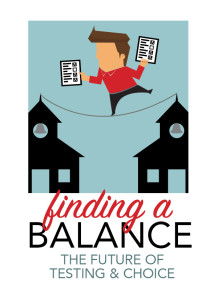Note: This is the fifth installment of our guest series on testing and educational choice. See the previous entries here. Coming Tuesday: Jason Bedrick of the Cato Institute.
by Tony Bennett
The current issues with standardized testing, and the potential solution to those issues, both lie in the same place: Alignment to the standards. It's kind of wonky issue, but I think it holds the key to a more workable accountability system. Let me explain.
 When we began the whole Common Core movement in earnest back in 2010, most of us reformers had a shared belief. We agreed the next generation of assessments needed to be closely aligned to the new standards, all the way down to the item level. That is deep alignment. We wanted to be confident that questions on the tests would measure students’ progress toward meeting all the granular expectations within the standards.
When we began the whole Common Core movement in earnest back in 2010, most of us reformers had a shared belief. We agreed the next generation of assessments needed to be closely aligned to the new standards, all the way down to the item level. That is deep alignment. We wanted to be confident that questions on the tests would measure students’ progress toward meeting all the granular expectations within the standards.
Deep alignment would give states the confidence they needed to use the tests to assign school grades and assemble data for teacher evaluations. It would also give local school administrators a sense of security when it came time to evaluate teachers and make personnel decisions based on assessment data. Both of those are good things.
Conversely, deep alignment between the test and the standards creates some significant problems. Many of those problems led us to the current outcry by both the education establishment and some school choice advocates against assessment.
The first of those problems is testing time. Since the advent of the two multi-state assessment consortia, states have seen the time spent assessing students increase significantly. It's now common for students to spend about nine hours on their year-end assessments. If you want a test that is deeply aligned to the standards, you simply have to build a longer test to cover all the material.
Second, if students are taking tests that are so deeply aligned to the standards, that tends to dictate things like curriculum and instruction. This phenomenon feeds the "teaching to the test" and other claims about the erosion of local control, teacher creativity and the ability for some schools to break conventions.
So how do you thread this needle? How do you create rigorous assessments that measure what students need to know, without setting tough testing schedules or dictating curriculum?
Without sounding too self-serving, I think we were on our way back in 2013 when Florida began to discuss a "Plan B" for assessments.
I believe assessment can and should have a strong element of local control. Local schools of all types should be in a position of greater control over assessment, thus allowing schools to choose an assessment that best serves their student populations, their individual curriculum, and their instructional strategies.
It also puts a greater emphasis on "the market." It enables states to get out of the business of trying to build tests, which can be difficult and expensive.
We know there are two major players in the market when it comes to college and career readiness assessments: College Board and ACT. Ironically, both of those assessments are around 4 hours long. They're designed to measure whether students are on track to succeed in college, and the data they provide is good enough to inform admissions and scholarship awards. I would allow school districts or local schools to choose between College Board and ACT for high school students.
States can also approve and provide career-readiness assessments for students in career and technical programs. For grades 3-8, states could seek proposals for one or more assessments schools could use. Ideally, they would approve multiple high-quality providers and allow schools to choose between them.
These assessments should meet the following criteria:
Above all, the tests should give parents and the public a clear measure of whether students are on track to graduate from high school with the academic skills they will need to excel in college or the workforce.
With this model, we could achieve a number of things.
First, the assessments would be largely relevant to the parents and students. This would provide a much greater level of buy-in. Given the stature of the SAT and ACT in today's educational environment, it could help overcome the opt-out problems we see today. Along those lines, we would see more private schools become part of the state accountability and transparency systems because they already use or see the value in these assessments.
Second, we shorten testing time. No more 9-hours-or-more tests.
Finally, states and local school districts could hold schools and educators accountable for data from assessments that aligns at the "cluster" or "domain" levels -- something SAT and ACT already do. To translate this from edu-speak, we can measure whether students are making progress toward college and career readiness, without holding them to the granular level of detail of individual standards, which leads to longer tests and less flexibility for schools.
The result would be shorter assessments, a vehicle for school and teacher accountability that doesn't provoke too much "teaching to the test" rhetoric, and greater local control.
Throughout my career I have pushed for increased educational choice and higher standards. I hope we can build versatile testing systems that help states achieve both goals at the same time. After two years of work and observing the craziness in assessment, I am more convinced than ever that it is still a viable solution today.
Tony Bennett, the author of this post, does not personally represent the organizations behind the SAT or ACT.